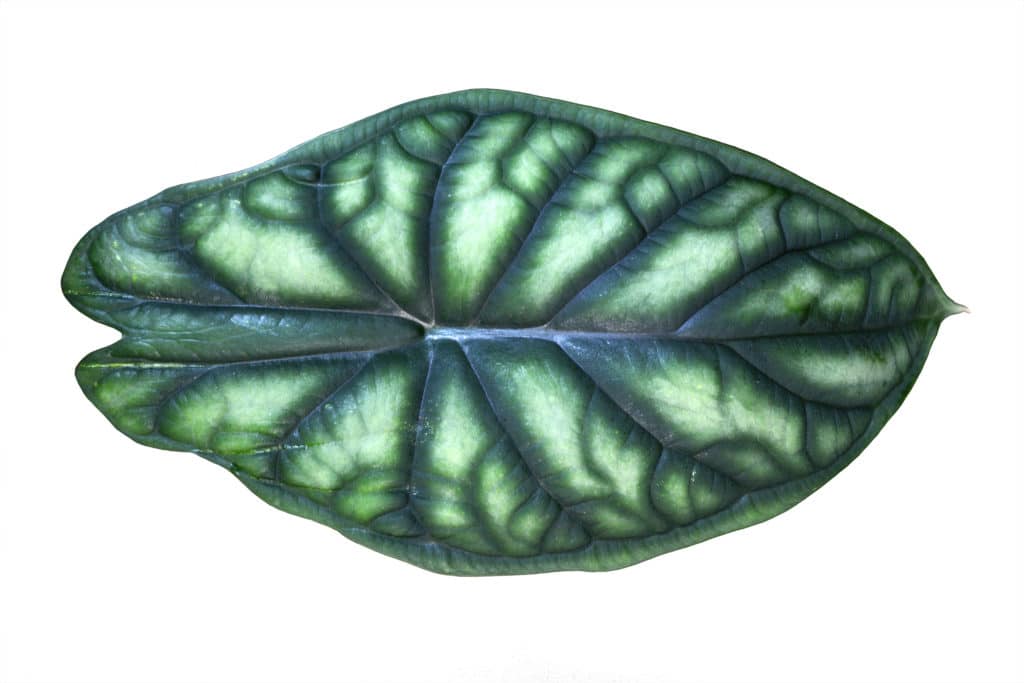
The Alocasia Dragon Scale Plant is a beautiful, textured plant with the look of granite. It’s loved for its shimmers and texture and it can be found in many gardens. The Dragon Scale is a rhizomatous plant included in the Araceae family and genus Alocasia. But there are some needs to keep in mind when caring for this plant or else you might find yourself disappointed!
In this blog post, we will examine everything you need to know about Alocasia Dragon Scale care from temperature requirements, light levels, humidity levels, watering schedules, and more!
Review of the Alocasia Dragon Scale (Alocasia baginda)
Alocasia Dragon Scale, also known as Alocasia baginda ‘Dragon Scale,’ has a stunning veined texture that is comparable to dragon scales. The leaves have the ability to bend and stretch while retaining their toughness and flexibility.
The Alocasia Dragon Scale is a cultivated variety of Alocasia baginda, which is native to the tropical forests of Borneo. It’s one of the gorgeous “gem” Alocasias, a collection of delicate rainforest flora with specific requirements.
‘Alocasia Dragon Scale’ has dark green leaves that get lighter toward the middle, giving the brighter hue a sparkling sheen. The undersides are pale cream, with vivid crimson veins. As the foliage matures, its color becomes more intense.
The plant is attractive in any size, and it looks good on its own or alongside other plants. It thrives under tight conditions and makes a wonderful terrarium plant.
Alocasia Dragon Scale Information
Scientific Name Alocasia baginda ‘Dragon Scale’
Origin Borneo
Light Requirements UVA and UVB rays cause leaves to yellow, brown, and eventually die. Leaves should be exposed to bright, indirect light instead. Direct sunlight will scorch the leaves.
Watering When the top 2-3 inches of soil feels dry, water. Overwatering is a major cause of many difficulties, so don’t do it.
Soil A chunky, well-draining potting mix is required. A combination of equal parts perlite, orchid mix, and coco coir works well.
Temperature 55°F (13°C) to 80°F (27°C). Dormancy may be induced by chilly temperatures.
Fertilizer Fertilization is not required. A half-strength, balanced fertilizer introduced every six weeks from spring to early fall is adequate.
Humidity It’s very important to use a high-humidity environment. A concentration of 60-80% is ideal.
Flowering Extremely valuable in the garden because of its beautiful leaves, which grow to be brilliant yellow-green by fall. Small purple spathes emerge beside the lovely foliage, which fades against the magnificent canopy. Consider pruning blooms to save energy for later growth.
Pruning Simply remove the leaves that are too thick or otherwise unsuitable. There is no need to trim excessively. Dead or damaged vegetation should be pruned away. To prevent pests or illness, remove dead plant material from the container.
Propagation The Alocasia Dragon Scale is best propagated by cutting tubers.
Re-Potting Repot with extreme caution only if absolutely necessary. Repotting is extremely distressing to them.
Diseases and Pests The most prevalent pests are aphids, scale, mealy bugs, and spider mites. The early detection and treatment of Alocasia Dragon Scale is critical. Leaf spot diseases are quite frequent. Remove any damaged leaves as soon as possible
Toxicity When used externally, the berries are harmless to the skin. If ingested, they can irritate the skin and cause dermatitis. Take extra precautions with dogs and children.
Light Requirements
Most Alocasias require high light, and the Dragon Scale is no exception. It thrives in bright indirect sun with a few hours of direct sunlight each day. If you lack adequate lighting, your plant may become leggy or produce smaller leaves.
If possible, place it near an east-facing window for at least three to four hours per day during spring through fall. The ideal temperature range for them outdoors is 55°F (13°C) – 80°F (27°C). Leaves will burn if exposed too long to midday summer heat. A little shade from deciduous trees can help keep them cool when temperatures are extreme.
In wintertime bring indoor plants closer to a sunny west-facing window so they can continue to get some direct sunlight.
Watering
The soil should be kept moist, but not wet. Check the top two to three inches of soil for moisture before watering. Overwatering is one of the most common reasons for plant problems, so try to be careful. Water less frequently in winter when growth slows.
A good way to tell if a plant needs water is to stick your finger in the potting mix-if it’s dry, give it some water! You can also use an inexpensive moisture meter from any garden center or hardware store.
Soil and Fertilizer
Alocasia Dragon Scale plants enjoy a well-draining mix with plenty of organic matter. A combination of equal parts perlite, orchid mix, and coco coir works well.
This plant does not need any fertilizer if the above-mentioned soil mixture is used. If you choose to add slow-release granular fertilizer at a rate of one half-strength application every six weeks from spring through fall, that will suffice for nutrition as long as there’s plenty of light.
The Dragon Scale doesn’t require more than this unless it shows signs of nutrient deficiency; in which case use an organic soluble formula such as Schultz’ Easy Green (the original version) instead.
Plant Pests and Diseases
There are several potential problems with Alocasia Dragon scales: aphids, scale insects, mealybugs and spider mites. Inspect new plants carefully before bringing them indoors to keep them from bringing pests into your home.
If you notice white, cottony masses on the undersides of Alocasia Dragon Scales leaves (or any plant) it is usually scale insects or mealybugs. These are almost always present in indoor plants and they secrete a sticky substance called honeydew which can attract ants.
A good spray with insecticidal soap should take care of both problems; do not use oil sprays as they will only make matters worse! Insecticidal soaps may be obtained at most garden centers; if not available ask for their assistance to help choose one that’s right for your purposes – many people have allergies to chemicals but don’t know it until exposed – better safe than sorry.
If the plant is outdoors, a strong blast of water from the hose should dislodge most of the pests. Repeat every few days until they’re gone.
Alocasia Dragon Scale leaves may also develop leaf spot diseases; these are caused by numerous fungi and bacteria. The spots are usually circular or elliptical, and their centers may be yellow, brown or black.
Remove any diseased foliage as soon as possible to help prevent the disease from spreading. Fungicides are available but can be harmful to both people and pets, so use them with caution (or not at all).
Temperature
Most Alocasias prefer warm temperatures, and the Dragon Scale is no exception. It thrives in bright indirect sun with a minimum temperature of 60°F (16°C). If you live in a colder climate, a south-facing window may get too much sun for the plant’s liking, so consider an east or west-facing one instead.

Growing Alocasia Dragon Scales from Seed
Alocasias are generally propagated by division, but because you’re growing indoors and want to keep your plants small, it’s probably better to grow from seed since that will take longer than dividing them!
If you’d like a larger plant faster though (and have some patience), then go ahead and divide them first before potting up the babies.
The easiest way to germinate alocasia seeds is on damp paper towels in plastic bags kept at room temperature; they should sprout within two weeks if conditions are right.
A couple of days after the seeds have germinated, carefully transplant them into small pots (three inches or so is fine) filled with a moistened potting mix.
Keep in a warm place and water regularly; they should be ready to plant outdoors when all danger of frost has passed.
When growing Alocasia from seed it’s important not to let the soil dry out completely – this will kill the young plants. The best way to avoid this is by sticking your finger in the potting mix-if it’s dry, give it some water!
You can also use an inexpensive moisture meter from any garden center or hardware store.
Alocasia Dragon Scale plants enjoy a well-draining mix with plenty of organic matter. A combination of equal parts potting soil, compost, and vermiculite is a good place to start.
Simple Pruning
Alocasia Dragon Scale plants don’t require much pruning, but if you need to tidy it up a bit, just cut off the dead or damaged parts of the plant at the soil level. You can also pinch out the growing tips occasionally to encourage branching and a fuller plant.
Use clean instruments to prune the afflicted stem near the base.
Alocasia Dragon Scale Dormancy
It’s crucial to be aware of the term “dormancy” when it comes to Alocasia Dragon Scale care. It generally happens as a result of reduced light or temperatures, and it tends to occur in winter, although it can happen at any time of year. The plant may stop growing and existing leaves might fall or decay.
Allow the soil to almost completely dry before watering, and provide moderate light and temperature levels. Your Alocasia Dragon Scale will begin to grow again in a few months.
The thick, nutrient- and water-containing tubers that develop beneath the soil are the source of Alocasia Dragon Scale. Do not throw your plant away even if all of its leaves fall off.
Simply maintain reasonable temperatures and wait until your plant begins to grow once more.
